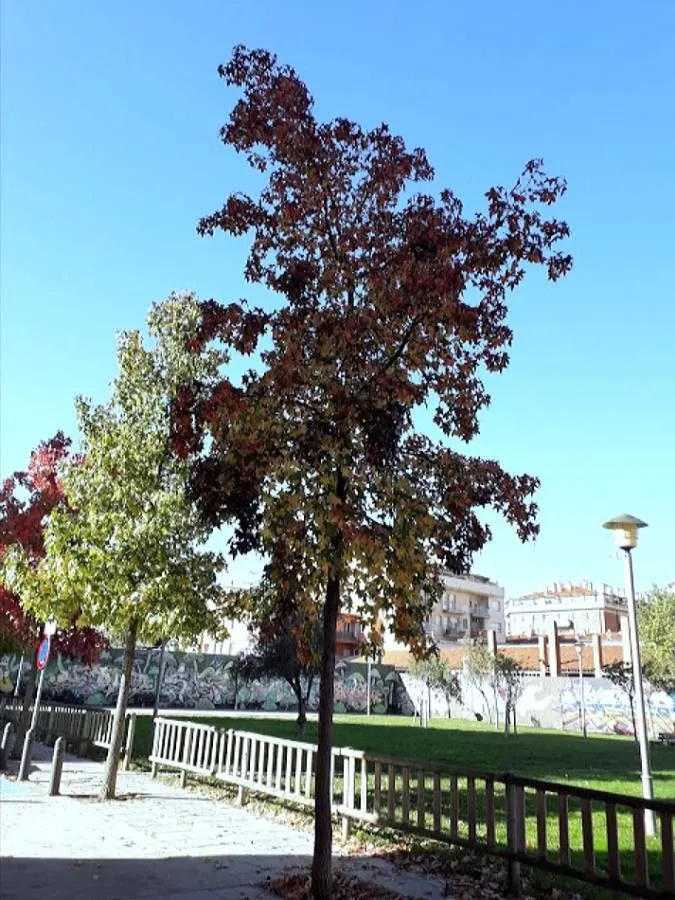
Author: L.
Bibliography: Sp. Pl.: 999 (1753)
Year: 1753
Status: accepted
Rank: species
Genus: Liquidambar
Vegetable: False
Observations: C. & E. U.S.A. to C. America
Alligator-wood, known scientifically as Liquidambar styraciflua, is a prominent and distinctive tree native to the central and eastern regions of the United States, extending down through Central America. First classified by the renowned botanist Carl Linnaeus in his seminal work “Species Plantarum” in 1753, this tree forms part of the Altingiaceae family.
This deciduous tree is notable for its striking, star-shaped leaves which turn vibrant shades of red, orange, and yellow during the fall, making it a favorite in ornamental landscaping. The foliage is not only visually appealing but also aromatic when crushed, emitting a pleasant, somewhat balsamic scent.
In its natural habitat, Alligator-wood thrives in moist, acidic soils and is typically found along stream banks and in bottomlands. It can reach considerable heights, often growing between 60 and 100 feet tall, with a straight trunk clad in deeply furrowed, grayish bark that can sometimes appear to resemble alligator skin – a likely source of its common name.
Aside from its ornamental value, the wood of Liquidambar styraciflua is known for its strength and resilience, making it a useful material for making furniture, veneer, and other wood products. Additionally, the tree produces spherical, spiky seed pods that hang in clusters and persist through winter, adding to its unique appearance.
Historically, the gum harvested from the tree’s bark, called storax, has been used in medicinal applications and in the production of fragrances. The versatility and visual appeal of Alligator-wood make it an invaluable species both in its native ecosystems and in cultivated landscapes around the world.
Eng: american-storax, alligator-wood, red-gum, satin-walnut, sweet-gum, sweetgum, american sweet gum, american storax, sweet gum
Fra: copalme d’amérique, liquidambar
Swe: ambraträd
Deu: amerikanischer amberbaum
Ita: liquidambra d’america
Por: liquidâmbar
Nld: amerikaanse amberboom
En: Alligator-wood, Satin-walnut, American-storax, Red-gum, Sweet-gum, Sweetgum, American Sweetgum, Sweet gum, American Sweet Gum, American Storax, American red Gum, Bilsted, Hazelpine, Sap Gum, Styrax
Af: Amberboom
Hy: Լիքվիդամբար խեժատու
Az: Qatranlı likvidambar
Eu: Likidanbar
Ca: Arbre d’ambar
Zh: 北美枫香树
Hr: Američki likvidambar
Cs: Ambroň západní
Da: Viginsk Ambratræ, Virginsk Ambratræ
Nl: Amberboom, Amerikaanse amberboom
Fi: Lännenambrapuu
Fr: Copalme d’Amérique, Liquidambar
De: Amerikanischer Amberbaum
He: ליקוידמבר ליבני
Hu: Amerikai ámbrafa
It: Liquidambra d’America, Storace
Mk: Американски ликвидамбар
No: Ambratre
Fa: شیرینژد آمریکایی
Pl: Ambrowiec amerykański, Ambrowiec balsamiczny
Pt: Liquidâmbar, Liquidambar
Ru: Likvidambar, Ликвидамбар смолоносный
Sr: Амерички ликвидамбар
Es: Árbol del Ámbar, Copalillo, Liquidámbar
Sv: Ambraträd
Tr: Amerika amber ağaci
Taken Oct 1, 2020 by Rosset Oriol (cc-by-sa)
Taken Oct 13, 2019 by Nicolas Remeur (cc-by-sa)
Taken Nov 7, 2021 by Marine S (cc-by-sa)
Taken Dec 18, 2021 by Raymonde Wicky (cc-by-sa)
Taken Nov 25, 2021 by Samanta Galli (cc-by-sa)
Taken Jan 20, 2018 by Pep Secem (cc-by-sa)
Taken Apr 20, 2018 by Ricardo Aperador Rubio (cc-by-sa)
Taken Sep 16, 2019 by Mar Ocêana do (cc-by-sa)
Taken Nov 24, 2016 by Ignacio Conradi (cc-by-sa)
Taken May 31, 2020 by event.horizon.010111 (cc-by-sa)
Taken May 2, 2017 by 1 (cc-by-sa)
Taken Nov 8, 2017 by Marcek Polling (cc-by-sa)
Taken Aug 8, 2017 by Creu Lopez (cc-by-sa)
Taken Dec 6, 2021 by JM (cc-by-sa)
Taken Nov 12, 2017 by Kelly Steyer (cc-by-sa)
Taken Oct 25, 2015 by Tela Botanica − Alain BIGOU (cc-by-sa)
Taken Nov 21, 2019 by Felix (cc-by-sa)
Taken Jan 20, 2018 by Pep Secem (cc-by-sa)
Taken Jan 20, 2018 by Pep Secem (cc-by-sa)
Taken Jan 20, 2018 by Pep Secem (cc-by-sa)
Taken Apr 11, 2014 by Tela Botanica − Jean-Claude ECHARDOUR (cc-by-sa)
Taken Oct 16, 2022 by Jernej Knez (cc-by-sa)
Taken Apr 9, 2017 by Carlos Villasante (cc-by-sa)
Taken May 12, 2018 by Maurizio Azzini (cc-by-sa)
Taken May 4, 2020 by ricc.moi (cc-by-sa)
Taken Jun 28, 2020 by iserte jose (cc-by-sa)
Taken Dec 11, 2020 by Isa Isabelle Walgarth (cc-by-sa)
Taken Oct 23, 2022 by Nathalie Potel (cc-by-sa)
Taken Dec 30, 2021 by jean-jacques kelner (cc-by-sa)
Taken Nov 7, 2015 by EOL − jacobogre (cc-by-sa)
© copyright of the Board of Trustees of the Royal Botanic Gardens, Kew.
© copyright of the Board of Trustees of the Royal Botanic Gardens, Kew.
© copyright of the Board of Trustees of the Royal Botanic Gardens, Kew.
Growth form: Single Stem
Growth habit: Tree
Growth rate: Rapid
Ph maximum: 7.0
Ph minimum: 4.5
Light: 7
Atmospheric humidity: 4
Soil nutriments: 5
Family: Myrtaceae Author: (F.Muell.) K.D.Hill & L.A.S.Johnson Bibliography: Telopea 6: 402 (1995) Year: 1995 Status:…
Family: Rubiaceae Author: Pierre ex A.Froehner Bibliography: Notizbl. Bot. Gart. Berlin-Dahlem 1: 237 (1897) Year:…
Family: Sapindaceae Author: Koidz. Bibliography: J. Coll. Sci. Imp. Univ. Tokyo 32(1): 38 (1911) Year:…
Family: Asteraceae Author: A.Gray Bibliography: Pacif. Railr. Rep.: 107 (1857) Year: 1857 Status: accepted Rank:…
Family: Fabaceae Author: Medik. Bibliography: Vorles. Churpfälz. Phys.-Ökon. Ges. 2: 398 (1787) Year: 1787 Status:…
Family: Aspleniaceae Author: (Cav.) Alston Bibliography: Bull. Misc. Inform. Kew 1932: 309 (1932) Year: 1932…